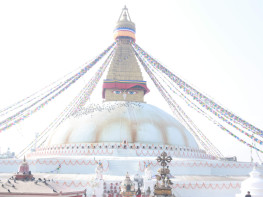
Bouddha Stupa
Bouddha (Nepali: बौद्धनाथ; Nepal bhasa: खास्ति चैत्य; Standard Tibetan: བྱ་རུང་ཁ་ཤོར།, romanized: Jhyarung Khashor also known as Boudhanath, is a massive spherical stupa in Kathmandu, Nepal, one of the largest in the world.
| Name: | Bouddha Stupa |
| Country / District: | Nepal , Kathmandu |
| Full Address: | kathmandu |
| Altitude: | 1350 meters |
| Special Attraction: | The special attractions of the Bouddha Stupa include its spiritual significance, architectural splendor, cultural heritage, prayer wheels and flags, monasteries and temples, and its allure as a renowned pilgrimage destination. |
Bouddha Stupa is the largest and most sacred Tibetan Buddhist site outside of Tibet forming a religion and culture hub for the Tibetan and people from the Himalayas of Nepal. The Stupa was on the ancient trade route from Tibet. The Stupa is claimed to have the relic of Kasyapa Buddha, the third Buddha of the Bhadrakalpa. Boudha Stupa, a UNESCO World Heritage Site significant for its historic and architectural significance, with sprouting monasteries and craftsmanship. It is said that the stupa is built by the mother Jyajhima, a poultry woman. She was very poor despite her poverty she had an intense desire for building a stupa. The mother passed away after she completed up to the vase, the dome-like structure. She had four sons, and the construction of the rest of the Stupa was completed by four sons. After they finished it, they all stood up in front of it and made prayers. Everyone made their wishes. When they were praying, all the buddhas and bodhisattvas were absorbed into the stupa, which is why the name of the stupa is also “All-Encompassing.” The stupa is a semicircular white dome and the towering spire, with unblinking eyes painted on each side that stares into the four directions.
The overall shape represents a Buddhist mandala (a cosmological map) and the path towards enlightenment, as well as the mythical center of the cosmos, Mount Meru. The four Dhyani Buddha signifies the crucial points, and the fifth, Vairocana is enshrined in the central white hemisphere of the stupa. The base of the stupa consists of three large platforms, decreasing in size. The square tower is topped by a pyramid with 13 steps, represents the stages that human beings must pass through to achieve nirvana. The triangular shape is the abstract for the elements of fire. Every portion has a symbolic significance: the base, dome, spire, and pinnacle represent the five elements.
